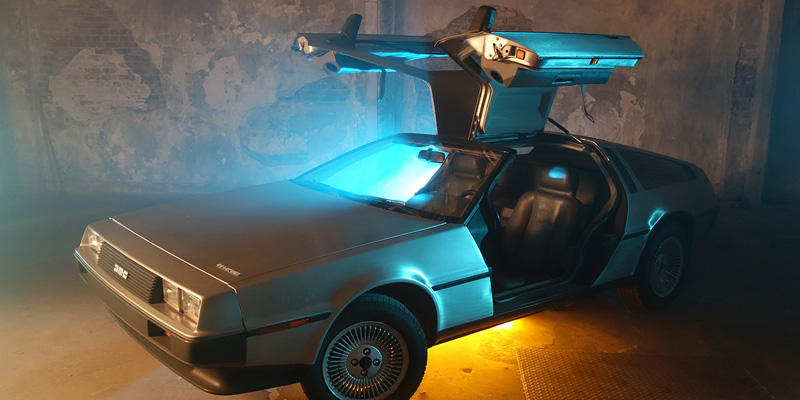Biff Tannen Got the Better Deal
Except it didn’t. Everywhere we’re told that things are changing faster and faster driven by ever accelerating technology. Moore’s Law and exponential curves are modern paradigms. Unfortunately, rather than accelerating, the rate of technological change has, in most areas, slowed down or even ground to a halt completely over the last 30 years (we’ll get to the future’s ‘ace in the hole’ internet later). Apart from that computer in your pocket (‘phone’ is an accident of history) Biff saw more progress in the 30 years from 1955 to 1985 than Marty did from 1985 to today. Looking at pictures of Pluto on your iPhone you might think this is a crazy idea. What could be more futuristic? Let’s see.
Pictures of Pluto are very impressive. So are the various generations of rovers on Mars and the images from astroids and comets. Marty has seen a lot of marvelous things in the last 30 years. But…
Biff was there for the development of spaceflight. He saw the first man and woman in space, a string of space stations with Skylab, and Salyutes, the first pictures of Jupiter and Saturn from Pioneer and Voyager, Venus and Mars landers with Venera and Viking. He got to see the development and flight of the first space plane with the start of the Shuttle programme not to mention the first man on the Moon – the culmination of centuries of human dreams. Marty would be feeling a little short-changed in the human spaceflight department today. Russia flying 50 year old Soyuz designs, no US space capability at all and only the almost forgotten ISS to fly the flag on the final frontier.
Transport technology in general doesn’t fare much better. Apart from a tiny percentage of hybrid and electric vehicles, Marty’s 2015 car runs the same sort of oil burning internal combustion engine his dad drove in 1985 – or that Biff drove in 1955. While Biff saw the development of Jumbo Jets and Concorde breaking records across the Atlantic, Marty has seen commercial jets shrink and slow in the name of efficiency. Despite regular magalev promises, 2015 trains are still resolutely welded to steel wheels on steel rails pulled by diesel-electric engines that wouldn’t look out of place on 1955 railroads.

not so much.
Image: Ziff-Davis Publishing / J. Allen St. John / Public domain
Biff could reasonably expect his future to be powered by clean, safe nuclear fuel. The Russians had started up the world’s first commercial reactor in ’54 and the West followed in ’56 with the UK’s Calder Hall reactor. For Marty, the fission dream has flatlined and we rely mostly on gas and coal burning stations that Biff would have thought old-fashioned 60 years previously. Meanwhile, fusion power is still 20 years away, same as it’s always been.
How about medical advances? The last 30 years must have seen a lot of ground gained there? Sure, Marty got the Human Genome Project and Stem Cells but good luck finding them in your local pharmacy. Biff had already seen the first successful Kidney transplant in 1954 and the next 30 years were filled with more and more firsts – including the first heart transplant in 1967 – saving thousands of lives. At the edge of life – the very young, the very old, the very sick – there have been definite advances. In practice though, what most of us mostly go to the doctor for today is the same miracle drug the Biff Tannens went for in the 50’s – antibiotics (except ours don’t work as well). Biff would be thankful for another miracle drug even if he didn’t use it directly. The Pill may not seem terribly technological but the very concept was science fictioney enough to rate a mention in Arthur C. Clarke’s 1954 book ‘Childhood’s End’. Clarke predicted oral contraceptives would “sweep away the last remnants of the Puritan aberration”. The development of reliable contraceptives did indeed help fuel the counter culture of the ‘60’s and drove a profound social revolution in women’s role in society.
And what of the future’s ace card, the Internet? Well computers in the home would be no surprise to 1985’s Marty. They’d been growing in popularity since the late 70’s and by the time Doc’s DeLorean was scorching the parking lot in ’85, Commodores, Ataris, Apples, TRS80s, Amigas and even the occasional Mac were a common fixture in teenage bedrooms. Even computer networks wouldn’t be wholly unknown. Arpanet and the Computer Science Network (CSNET) were old hat to university computer departments while Bulletin Boards were exploding in popularity thanks to the development of 300 baud modems. Had Marty ever holidayed in France he would have experienced the Minitel system – a sort of national, low res Internet – where French folk had been reading news, booking plane tickets, hiring prostitutes and having inappropriate conversations with strangers on-line since 1982. While the Internet has leapfrogged the old Minitel hundreds of time over in depth, quantity of information and quality (prostitutes are much higher resolution now), in many respects it’s just more not new. Once he’d had his fill of porn and cat gifs, Marty’s response to the real 2015 would probably be “Is that it?”
The Biff Tannens of ’55 grew up to spaceflight, heart transplants, contraception, nuclear power and supersonic planes. The Marty McFlys of 1985 grew up to…well, videophones. The Biff Tannens got the glowing technological destiny they were promised by pulps and B movies. The Marty McFlys? We console ourselves with our flatscreens and smartphones – props from some cancelled SF future that never made it past the first season. We goggle at a relentless stream of prototypes and ‘breakthroughs’ that somehow never pan out and tell ourselves this time, for sure, it’s all just around the corner. And maybe it is. The next thirty years may very well bring some (hopefully benign) transgressive technology that transforms the human experience. The reality though, for the McFly generation at least, is that the future never arrived.



